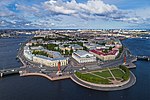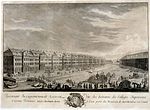The Library of the Russian Academy of Sciences (Russian: Библиотека Российской академии наук (БАН)) is a large state-owned Russian library based in Saint Petersburg on Vasilievsky Island and open to employees of institutions of the Russian Academy of Sciences and scholars with higher education. It is a part of the academy and includes, besides the central collection, the library collections housed by specialized academic institutions in Saint Petersburg and other cities.
The library was founded in Saint Petersburg by a decree of Peter I in 1714 and subsequently included into the structure of the St. Petersburg Academy of Sciences. Since 1747 all academic institutions and since 1783 all publishers in the country have been legally obliged to provide the library with a free copy of each published item.
In 1728-1924 its collections were stored in the building of Kunstkamera, with which it had formed a single academic institution until 1803. In the 1920s the library received many items confiscated during nationalization in Soviet Russia.
In 1924-1925 the collections were transferred to the new building built for the library in 1914 and occupied by a military hospital during the First World War.
During the siege of Leningrad in 1941-1944 the collections stayed in the besieged city and the library was open.
On February 15, 1988, the library suffered the most catastrophic fire in its history which destroyed or damaged a considerable part of the collections,it had destroyed 298.000 books of the total 12 million housed,two to three million more were damaged by heat and smoke. 734,465 copies volumes initially became damp due to firefighting foam. Many of the lost volumes were part of the Baer Collection of foreign scientific works: 152.000 were lost. The rest 146.000 were Russian books, many of them early scientific and medical books from the 17th, 18th, and 19th centuries.
The damp books damaged by fire extinguishment were initially frozen. Then a radio appeal was broadcast for citizens to dry the damp books in their homes. By late March 1988 93% of the damp books had been dried in that way and returned to the library. However, about 10,000 books became moldy.
The lost fund was partially restored,large batches of books and individual rare editions came from more than 760 domestic libraries to replenish the lost funds.
In a 2018 article on the web site "Siberian scientific news" it says that the fire destroyed 298 061 copy of monographs and periodicals; 146,716 books in Russian; 152,245 copies of foreign publications before 1930, arranged according to the classification system of academician Karl Baer (including the legendary Baer fund - about 62 thousand folios). The lost fund was replenish with 222,336 copies from 764 institutions were accepted for the restoration of funds. The loss of 62% of domestic books and 8% of publications from the Baer collection has been replenished. Also destroyed were 20,640 binders, or one third of the newspaper stock,this fund was also partially restored.
Other sources say that 45% of the burned books in Russian and 13% in foreign were recovered.Before the fire, as of October 1, 1986, the collection of the library and libraries subordinate to it consisted of 17,288,365 items.












